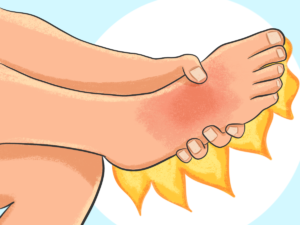Diabetes is a condition where the human body cannot properly process sugar, which leads to high blood sugar levels. This long-term condition can cause various health problems, including issues with the feet. One common problem that people with diabetes face is a foot burning problem. Understanding this issue, knowing how to manage it, and finding treatment for burning feet can greatly improve this situation.
What is diabetes?
Diabetes is a long-term medical condition where the body either does not produce enough insulin or cannot use insulin effectively. A hormone called insulin helps improve the body’s ability for cells to take in glucose, or sugar, from the blood and use it as fuel. When this process is disrupted, glucose settles up in the blood, leading to high blood sugar levels. High blood sugar can harm the body’s blood vessels and nerves over time.
How is diabetes related to foot burning?
One of the complications of diabetes is nerve damage, also known as diabetic neuropathy. This condition affects the nerves, particularly in the legs and feet, and can cause various symptoms, including a burning sensation. The foot burning problem often comes from damage to the small nerves in the feet, which can also cause tingling, numbness, and pain. With this numbness and other problems, usually, diabetics usually fail to notice any foot injuries, scratches, or wounds. This nerve damage occurs because high blood sugar levels can injure the walls of the small blood vessels that supply the nerves with oxygen and nutrients.
Other problems associated with diabetes and foot
Diabetes can cause several additional foot-related issues in addition to burning feet:
- Ulcers: Open sores or ulcers can develop due to reduced blood flow and nerve damage. These ulcers do not heal fast and can become infected quickly.
- Infections: People with diabetes are more prone to infections because high blood sugar levels can weaken the immune system. Infections can be severe and may lead to complications.
- Poor circulation: Diabetes can cause poor blood flow, making it harder for wounds to heal and increasing the risk of foot problems.
- Foot defects: Nerve damage can lead to muscle weakness and changes in the color and shape of the feet, causing deformities like hammertoes and bunions.
Treatment for diabetes foot burning
Managing the burning sensation in the feet caused by diabetes involves several strategies:
- Blood sugar control: Maintaining blood sugar levels within the targeted range is essential. This can help protect your feet from further nerve damage and improve symptoms. Monitoring blood sugar regularly, following a healthy diet, and taking medications as prescribed are essential steps while following treatment for burning feet.
- Medications: There are specific medications available to treat nerve pain and burning sensations. These include anticonvulsants, antidepressants, and pain relievers. A doctor can recommend the best medication based on individual diabetes and foot needs.
- Foot care: It is essential to take care of your feet to avoid problems. This includes daily inspection of the feet for cuts or wounds, keeping feet clean and dry, and wearing properly fitting shoes and socks.
- Lifestyle changes: Regular exercise can improve blood flow and help manage blood sugar levels. Quitting smoking and reducing alcohol intake can also improve overall health and reduce symptoms.
- Pain management techniques: Techniques such as warm baths, massage, and relaxation exercises can help manage pain and discomfort. After washes it is important to dry your feet properly and apply fragrance free moisturiser.
- Footwear: Footwear plays a major role, wear comfortable footwear with inbuilt cushion for care. Always prefer shoes or cover slippers instead of using open-ended flip-flops.
Foot burning problem due to diabetes is a common and uncomfortable one, but they can be managed with proper care and treatment for burning feet. Understanding the relationship between diabetes and foot health is the first step in taking control. By maintaining good blood sugar control, using appropriate medications, practicing good foot care, and making healthy lifestyle changes, individuals with diabetes can reduce the burning sensation in their feet and improve their quality of life. Regular check-ups with a healthcare provider are also important to monitor and manage any foot-related complications.
